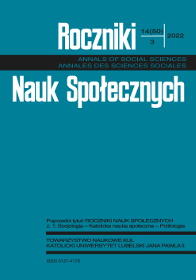Pandemic Holidays: A Typology of Attitudes Towards Changes in Family Practices During Crisis in the Light of Polish Qualitative Data
Abstract
The COVID-19 pandemic engendered changes in the area of family practices, including those related to the celebration of holidays. Traditional rituals and familiar ways of demonstrating familiarity had to undergo immediate and often unwanted modifications. The research results show reactions to these changes, which encompass embracing new practices, relief connected with forgoing old rituals, as well as negative evaluations of the modified family celebration practices. The analysis of the changes in holidays-related family practices resulted in a more universal proposal of attitudes towards changing family practices during social crises.
References
Adams B. (2010), Themes and Threads of Family Theories: A Brief History, Journal of Comparative Family Studies, 41, nr 4, s. 499-505.
Aherfi S., Gautret P., Chaudet H., Raoult D., La Scola B. (2020), Clusters of COVID-19 associated with Purim celebration in the Jewish community in Marseille, France, International Journal of Infectious Diseases, 100, s. 88-94.
Aronson E., Wilson T., Akert R. (2003), Social psychology, New Jersey: Pearson.
Boccia S. (2021), Christmas Festivities and COVID-19: A Foreseeable Risk to Anticipate, Frontiers in Public Health, 8, s. 639-647.
Cheal D. (1999), The one and the many: modernity and postmodernity, The Sociology of the Family: A Reader, Oxford: Blackwell Publishers.
Finch J. (2007), Displaying Families, Sociology, 41, nr 1, s. 65-81.
Fraenkel P., Cho W.L. (2020), Reaching up, down, in, and around: Couple and family coping during the coronavirus pandemic, Family Process, 59, nr 3, s. 847-864.
Gawrońska M., Sikorska M. (2022), Rodziny na widoku – koncepcja demonstrowania rodzinności jako narzędzie użyteczne do analizowania życia rodzinnego, Studia Socjologiczne, nr 1(244), s. 137-164.
Gerhardt U. (1991), Typenbildung, [w:] U. Flick et al. (red.), Handbuch Qualitative Sozialforschung. Grundlagen, Konzepte, Methoden und Anwendungen, München: Psychologie Verlags Union, s. 435-439.
Giddens A. (1992), The transformation of intimacy: sexuality, love and eroticism in modern societies, Stanford: Stanford University Press.
Gulland J. (2020), Households, bubbles and hugging grandparents: Caring and lockdown rules during COVID-19, Feminist Legal Studies, 28, nr 3, s. 329-339.
Imber-Black E. (2020), Rituals in the time of COVID-19: imagination, responsiveness, and the human spirit, Family Process, 59, nr 3, s. 912-921.
Jamieson L. (1998), Intimacy: Personal Relationships in Modern Societies, Cambridge: Polity Press.
Kapoor V., Belk R., Goulding C. (2022), Ritual Revision During a Crisis: The Case of Indian Religious Rituals During the COVID-19 Pandemic, Journal of Public Policy & Marketing, 41, nr 3, s. 277-297.
Mariański J., Zaręba S.H. (2021), Rodzina jako wartość w czasie pandemii, Roczniki Nauk Społecznych, 49, nr 2, s. 5-21.
Marshall G. (1994), Oxford dictionary of sociology, Oxford: Oxford University Press.
McCarthy J., Edwards R. (2011), Key Concepts in Family Studies, London: Sage.
Miles M., Huberman A. (1994), Qualitative data analysis: An expanded sourcebook, London: Sage.
Morgan D.H. (1996), Family Connections: An introduction to family studies, Cambridge: Polity Press.
Morgan D.H. (2011), Rethinking Family Practices, Hampshire: Palgrave Macmillan.
Neale B. (2019), What is qualitative longitudinal research?, London: Bloomsbury.
Popyk A., Pustułka P. (2021), Transnational Communication between Children and Grandparents during the COVID-19 Lockdown: The Case of Migrant Children in Poland, Journal of Family Communication, 21, nr 3, s. 223-237.
Pustulka P., Buler M. (2022), First-time motherhood and intergenerational solidarities during COVID-19, Journal of Family Research, 34, nr 1, s. 16-40.
Pustułka P., Ślusarczyk M. (2016), Cultivation, compensation and indulgence: Transnational short-term returns to Poland across three family generations, Transnational Social Review, 6, nr 1-2, s. 78-92.
Pustułka P., Radzińska J., Kajta J., Sarnowska J., Kwiatkowska A., Golińska A. (2021), Transitions to Adulthood during COVID-19: Background and Early Findings from the ULTRAGEN Project, Youth Working Papers, 4, s. 1-65.
Saldana J. (2014), The Coding Manual for Qualitative Researchers, London: Sage.
Salner P. (2020), Jewish Holidays in the Time of the Corona Virus Pandemic in Slovakia, Occasional Papers on Religion in Eastern Europe, 40, nr 6, s. 110-121.
Seymour J., Walsch J. (2013), Displaying Families, Migrant Families and Community Connectedness: The Application of an Emerging Concept in Family Life, Journal of Comparative Family Studies, 44, nr 6, s. 689-698.
Shannon C.S. (2019), #Family: Exploring the Display of Family and Family Leisure on Facebook and Instagram. Leisure Sciences, New Brunswick: University of New Brunswick, s. 2-33 (online).
Singh R., Sim T. (2021), Families in the Time of the Pandemic: Breakdown or Breakthrough?, Australian and New Zealand Journal of Family Therapy, 42, nr 1, s. 84-97.
Wilding R. (2006), ‘Virtual’ intimacies? Families communicating across transnational contexts, Global Networks, 6, nr 2, s. 125-142.
Copyright (c) 2022 Roczniki Nauk Społecznych

This work is licensed under a Creative Commons Attribution-NonCommercial-NoDerivatives 4.0 International License.


